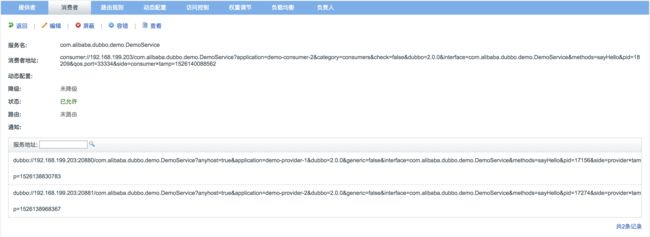介绍
在集群容错时,dubbo处理的流程如下图所示:
下面是来自官网的介绍,各节点关系如下:
- 这里的
Invoker是Provider的一个可调用Service的抽象,Invoker封装了Provider地址及Service接口信息 -
Directory代表多个Invoker,可以把它看成List,但与List不同的是,它的值可能是动态变化的,比如注册中心推送变更 -
Cluster将Directory中的多个Invoker伪装成一个Invoker,对上层透明,伪装过程包含了容错逻辑,调用失败后,重试另一个 -
Router负责从多个Invoker中按路由规则选出子集,比如读写分离,应用隔离等 -
LoadBalance负责从多个Invoker中选出具体的一个用于本次调用,选的过程包含了负载均衡算法,调用失败后,需要重选
本篇将介绍这里的 Directory。
Directory的定义
看下 Directory 的类图:
这里有两种 Directory :RegistryDirectory 和 StaticDirectory。看名字就知道是什么意思了,第一种是通过注册中心获取,它的值可能是动态变化的;第二种是不会动态变化的,可以查看其构造方法:
public StaticDirectory(URL url, List> invokers, List routers) {
super(url == null && invokers != null && !invokers.isEmpty() ? invokers.get(0).getUrl() : url, routers);
if (invokers == null || invokers.isEmpty())
throw new IllegalArgumentException("invokers == null");
this.invokers = invokers;
}
这里的 invokers 只在构造时被设置了一次。本文主要介绍的是 RegistryDirectory。
看下 Directory 接口的定义:
public interface Directory extends Node {
/**
* get service type.
*
* @return service type.
*/
Class getInterface();
/**
* list invokers.
*
* @return invokers
*/
List> list(Invocation invocation) throws RpcException;
}
主要是 list 方法,该方法会列出所有的服务提供者。
代码分析
下面从官网给出的消费者的实例来进行分析:
public class Consumer {
public static void main(String[] args) {
//Prevent to get IPV6 address,this way only work in debug mode
//But you can pass use -Djava.net.preferIPv4Stack=true,then it work well whether in debug mode or not
System.setProperty("java.net.preferIPv4Stack", "true");
ClassPathXmlApplicationContext context = new ClassPathXmlApplicationContext(new String[]{"META-INF/spring/dubbo-demo-consumer.xml"});
context.start();
DemoService demoService = (DemoService) context.getBean("demoService"); // get remote service proxy
while (true) {
try {
Thread.sleep(1000);
String hello = demoService.sayHello("world"); // call remote method
System.out.println(hello); // get result
} catch (Throwable throwable) {
throwable.printStackTrace();
}
}
}
}
在调用 sayHello 方法时,会进入 MockClusterInvoker 中的 invoke 方法:
@Override
public Result invoke(Invocation invocation) throws RpcException {
Result result = null;
String value = directory.getUrl().getMethodParameter(invocation.getMethodName(), Constants.MOCK_KEY, Boolean.FALSE.toString()).trim();
if (value.length() == 0 || value.equalsIgnoreCase("false")) {
//no mock
result = this.invoker.invoke(invocation);
} else if (value.startsWith("force")) {
if (logger.isWarnEnabled()) {
logger.info("force-mock: " + invocation.getMethodName() + " force-mock enabled , url : " + directory.getUrl());
}
//force:direct mock
result = doMockInvoke(invocation, null);
} else {
//fail-mock
try {
result = this.invoker.invoke(invocation);
} catch (RpcException e) {
if (e.isBiz()) {
throw e;
} else {
if (logger.isWarnEnabled()) {
logger.warn("fail-mock: " + invocation.getMethodName() + " fail-mock enabled , url : " + directory.getUrl(), e);
}
result = doMockInvoke(invocation, e);
}
}
}
return result;
}
MockClusterInvoker 主要是进行本地伪装,这个在以后将 Cluster 的时候再详细介绍。
这里的第7行进入 AbstractClusterInvoker 中的 invoke 方法:
@Override
public Result invoke(final Invocation invocation) throws RpcException {
checkWhetherDestroyed();
LoadBalance loadbalance = null;
List> invokers = list(invocation);
if (invokers != null && !invokers.isEmpty()) {
loadbalance = ExtensionLoader.getExtensionLoader(LoadBalance.class).getExtension(invokers.get(0).getUrl()
.getMethodParameter(invocation.getMethodName(), Constants.LOADBALANCE_KEY, Constants.DEFAULT_LOADBALANCE));
}
RpcUtils.attachInvocationIdIfAsync(getUrl(), invocation);
return doInvoke(invocation, invokers, loadbalance);
}
...
protected List> list(Invocation invocation) throws RpcException {
List> invokers = directory.list(invocation);
return invokers;
}
这里可以看到,在 list 方法中调用了 directory 的 list 方法,这里的 directory 对象就是 RegistryDirectory 类型的对象,这里首先会调用 AbstractDirectory 中的 list 方法,然后再调用子类自己实现的 doList 方法:
AbstractDirectory 中的 list 方法:
@Override
public List> list(Invocation invocation) throws RpcException {
if (destroyed) {
throw new RpcException("Directory already destroyed .url: " + getUrl());
}
List> invokers = doList(invocation);
List localRouters = this.routers; // local reference
if (localRouters != null && !localRouters.isEmpty()) {
for (Router router : localRouters) {
try {
if (router.getUrl() == null || router.getUrl().getParameter(Constants.RUNTIME_KEY, false)) {
invokers = router.route(invokers, getConsumerUrl(), invocation);
}
} catch (Throwable t) {
logger.error("Failed to execute router: " + getUrl() + ", cause: " + t.getMessage(), t);
}
}
}
return invokers;
}
该方法主要有两个工作:
- 调用具体的
Directory列出可用的服务提供者; - 根据路由规则过滤。
这里先不考虑路由,看下 RegistryDirectory 中的 doList 方法:
@Override
public List> doList(Invocation invocation) {
if (forbidden) {
// 1. No service provider 2. Service providers are disabled
throw new RpcException(RpcException.FORBIDDEN_EXCEPTION,
"No provider available from registry " + getUrl().getAddress() + " for service " + getConsumerUrl().getServiceKey() + " on consumer " + NetUtils.getLocalHost()
+ " use dubbo version " + Version.getVersion() + ", please check status of providers(disabled, not registered or in blacklist).");
}
List> invokers = null;
Map>> localMethodInvokerMap = this.methodInvokerMap; // local reference
if (localMethodInvokerMap != null && localMethodInvokerMap.size() > 0) {
String methodName = RpcUtils.getMethodName(invocation);
Object[] args = RpcUtils.getArguments(invocation);
if (args != null && args.length > 0 && args[0] != null
&& (args[0] instanceof String || args[0].getClass().isEnum())) {
invokers = localMethodInvokerMap.get(methodName + "." + args[0]); // The routing can be enumerated according to the first parameter
}
if (invokers == null) {
invokers = localMethodInvokerMap.get(methodName);
}
if (invokers == null) {
invokers = localMethodInvokerMap.get(Constants.ANY_VALUE);
}
if (invokers == null) {
Iterator>> iterator = localMethodInvokerMap.values().iterator();
if (iterator.hasNext()) {
invokers = iterator.next();
}
}
}
return invokers == null ? new ArrayList>(0) : invokers;
}
这里的核心是 this.methodInvokerMap,Directory 获取 invoker 就是根据这个值,那么该值是在哪里被更新的呢?
由于是使用的 zookeeper 注册中心,看下上面的类图可以知道,是通过 ZookeeperRegistry 来进行更新的,ZookeeperRegistry 继承自 FailbackRegistry ,在 FailbackRegistry 中的 subscribe 方法会调用 ZookeeperRegistry 实现的 doSubscribe 方法进行更新:
@Override
public void subscribe(URL url, NotifyListener listener) {
super.subscribe(url, listener);
removeFailedSubscribed(url, listener);
try {
// Sending a subscription request to the server side
doSubscribe(url, listener);
} catch (Exception e) {
...
}
}
从上面的类图可以看到,RegistryDirectory 实现了 NotifyListener 接口,该接口定义了一个 notify 方法,doSubscribe 方法执行的最终会调用 RegistryDirectory 中的 notify 方法。
看下 notify 方法的实现,这里简化了一下代码:
@Override
public synchronized void notify(List urls) {
List invokerUrls = new ArrayList();
for (URL url : urls) {
String protocol = url.getProtocol();
String category = url.getParameter(Constants.CATEGORY_KEY, Constants.DEFAULT_CATEGORY);
if (Constants.ROUTERS_CATEGORY.equals(category)
...
} else if (Constants.PROVIDERS_CATEGORY.equals(category)) {
invokerUrls.add(url);
}
...
}
...
// providers
refreshInvoker(invokerUrls);
}
refreshInvoker 进行 methodInvokerMap 的更新:
private void refreshInvoker(List invokerUrls) {
if (invokerUrls != null && invokerUrls.size() == 1 && invokerUrls.get(0) != null
&& Constants.EMPTY_PROTOCOL.equals(invokerUrls.get(0).getProtocol())) {
this.forbidden = true; // Forbid to access
this.methodInvokerMap = null; // Set the method invoker map to null
destroyAllInvokers(); // Close all invokers
} else {
...
Map> newUrlInvokerMap = toInvokers(invokerUrls);// Translate url list to Invoker map
Map>> newMethodInvokerMap = toMethodInvokers(newUrlInvokerMap); // Change method name to map Invoker Map
...
this.methodInvokerMap = multiGroup ? toMergeMethodInvokerMap(newMethodInvokerMap) : newMethodInvokerMap;
this.urlInvokerMap = newUrlInvokerMap;
try {
destroyUnusedInvokers(oldUrlInvokerMap, newUrlInvokerMap); // Close the unused Invoker
} catch (Exception e) {
logger.warn("destroyUnusedInvokers error. ", e);
}
}
}
我们回到 AbstractClusterInvoker 中的 invoke 方法,再来看一下该方法:
@Override
public Result invoke(final Invocation invocation) throws RpcException {
checkWhetherDestroyed();
LoadBalance loadbalance = null;
List> invokers = list(invocation);
if (invokers != null && !invokers.isEmpty()) {
loadbalance = ExtensionLoader.getExtensionLoader(LoadBalance.class).getExtension(invokers.get(0).getUrl()
.getMethodParameter(invocation.getMethodName(), Constants.LOADBALANCE_KEY, Constants.DEFAULT_LOADBALANCE));
}
RpcUtils.attachInvocationIdIfAsync(getUrl(), invocation);
return doInvoke(invocation, invokers, loadbalance);
}
通过上面的分析可知,在 list 方法中,已经经过了 Directory 和 Router ,按照官网给出的集群容错的图,可以知道,下一步应该是 LoadBalance,从代码中也可以看到通过 SPI 来获取具体的 LoadBalance,然后执行具体的调用。
实例分析
下面来具体实践一下。启动两个服务,名字分别为 demo-provider-1 和 demo-provider-2:
启动一个消费者,名字为 demo-consumer-2:
在执行到 invoke 方法时,查看获取的 list :
查看消费者的通知信息:
至此, Directory 的分析就结束了,下篇文章会分析一下 Router 的实现。





